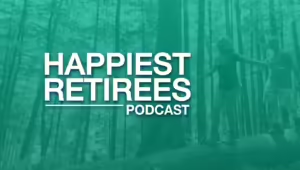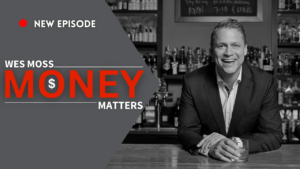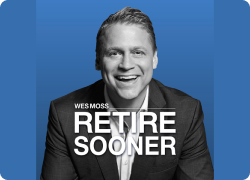Dive into an eye-opening discussion about confidently navigating the financial landscape. Unpack the latest market trends, tackle productive investment strategies, and uncover a potential key to building lasting wealth. Get insights on making your money work harder, optimizing your retirement plan, and sidestepping common financial pitfalls. Whether planning your next big financial move or just trying to keep up with economic shifts, this episode delivers knowledge to help you take control. Wes Moss and Jeff Lloyd turn complex financial topics into actionable steps for your financial future.
Read The Full Transcript From This Episode
(click below to expand and read the full interview)
- Wes Moss [00:00:02]:
The Q ratio, average convergence, divergence, basis points and BS Financial shows love to sound smart, but on Money Matters we want to make you smart.Wes Moss [00:00:14]:
That’s why the goal is to keep you informed and empowered.Wes Moss [00:00:17]:
Our focus providing clear, actionable information without the financial jargon to help 1 million families retire sooner and happier, bigger. Based on the long runnaing WSB radio show, this Money Matters podcast is tailor made for both modern retirees and those still in the planning stages. Join us in this exciting new chapter and let’s journey toward a financially secure and joyful retirement together.Wes Moss [00:00:47]:
Jeff Lloyd here in the studio. Thank you for being here. I know you’re excited about the time of season today. Of course we’re covering tariffs. Number one headline of the week. Who knows how many times it was mentioned. How does that gonna hit our wallets? JEFF lloyd, Is it gonna be a car crash or a fender bender? And we actually have an example. We have run on what I would say the staple of all staples when it comes to US American cars, and that is the United States.Wes Moss [00:01:17]:
General Motors, Chevy, a ho. We’re looking into the price and what the tariffs could mean for that. Speaking of, we have a famous car executive that we picked for this week just so happened to do an article in the Wall Street Journal all about his mixed metaphors and I think we call it malaprops that we’re going to go into just a little bit today for some levity. And then of course, I guess it’s it’s also baseball season. We we also wanted to talk about chime consumer spending, housing and inflation, interest rates, manufacturing, employment, earnings. To get a reading, we’re going to grade the US Economy A, B, C, D, E or F right now. And that’s all here on this hour. Jeff Floyd, welcome.Wes Moss [00:02:01]:
You love this time of year and.Jeff Lloyd [00:02:03]:
It’S not just baseball season. We had an opening day on Thursday. You got the Braves out on the West Coast. They’re playing the San Diego Padres. Then they go play the Dodgers. But a lot more than just baseball going on. You got March Mattis. We’re in the, we’re in the thick of it right now.Jeff Lloyd [00:02:17]:
We got the Masters here not next week, but the next. We also saw some interesting Masters news regarding the famed commentator Jim Nance and talking about golf and retirement.Wes Moss [00:02:30]:
What makes Jim Nance so good?Jeff Lloyd [00:02:32]:
It’s a familiar voice. It’s a soothing voice. You just associate him with the the best sports, whether it’s the the final four or the Masters.Wes Moss [00:02:41]:
It’s just he’s the best, he’s interesting and relaxing all at the same time. Well, so what’s the Jim Nance news?Jeff Lloyd [00:02:48]:
So he announced that he wants to retire in 11 years on the 100th anniversary of the Masters.Wes Moss [00:02:56]:
He wants to commentate it.Jeff Lloyd [00:02:57]:
So commentate for 11 more years. And the 100th masters is going to be his last.Wes Moss [00:03:02]:
What did he. There was a sport and I would say he does all sports pretty much. I mean there’s not a sporting event that he wouldn’t be amazing at and isn’t already amazing at, but it was there a sport that he stopped. Didn’t he consolidate a little bit in sport? Didn’t he. It wasn’t like.Jeff Lloyd [00:03:19]:
I can’t remember. I mean his focus is golf and football right now, but I can’t remember if there was another sport.Wes Moss [00:03:26]:
I don’t know if I’ve heard him do basketball.Jeff Lloyd [00:03:29]:
He’s still doing basketball anyway.Wes Moss [00:03:31]:
Well, okay, so he is thinking about. He’s saying he’s going to retire at the hundredth masters. He’s 65. Eleven years from now he’ll be 76. He’ll be 76. So I think he’s going to be okay. I looked up, he’s.Jeff Lloyd [00:03:47]:
Do you have any retirement planning advice for Jim Nance for the next 11 years?Wes Moss [00:03:52]:
When should he take his social.Jeff Lloyd [00:03:54]:
When should he.Wes Moss [00:03:55]:
I know he needs to wait.Jeff Lloyd [00:03:56]:
He’s still working, so let’s maybe wait until you’re 70.Wes Moss [00:03:59]:
He should still wait at least until 65 so he can skip the income penalty cap while he’s still working. I looked up his contract. He signed a big deal several years ago. He’s making at least 10 a year. He’s probably going to be a happy retiree. A lot of core pursuits. I’d count each individual sport as a core pursuit. He’s a huge fan of golf and basketball and football.Wes Moss [00:04:24]:
He’ll probably be commentating pickleball in his retirement. That’s what I could see him to win.Jeff Lloyd [00:04:28]:
What’s your gut tell you? Can he retire sooner than 2036 or do you think he needs to continue getting that $10 million check for 11 more years so he can retire happy?Wes Moss [00:04:38]:
Look, look, I have no idea. But I can tell you, as most people listening, you think, okay, of course he could retire right now. And the answer is probably that’s true. However, it’s less conceivable, but more that would not all of that out of the ordinary for folks that have these massive amount of earnings. Look, you could live in California and have a $20 million house and have a huge mortgage you could have seven cars. Jim Nance probably doesn’t, but that could happen. He could. The.Wes Moss [00:05:06]:
It’s not inconceivable that even though he has that much income that he still maybe couldn’t retire and still do the things he wanted to do. And I know that sounds crazy, but it is all relative and it just depends on lifestyle. Right. If he wants to fly private for the rest of his life, that $500,000 per year in order to really do that could be $1 million a year if you’re going all over the place. So he really depends on his spending goes back to the rich ratio. Right. If you’ve got ten grand a month in income, but and you only need eight, you’re rich. If you have 10 grand in income and you need 15, you’re not.Wes Moss [00:05:41]:
So I don’t know his specifics, but as crazy as it might sound, somebody with this much income, he may need to work a little longer. So either way, I love that he’s going to work because I love hearing him on tv. He’s the, the perfect mix of calm and excitement all at the same time. You did some statistics around payroll for mlb, which is really staggering to me. The disparity between some of these teams.Jeff Lloyd [00:06:05]:
Like we said we had opening day this past Thursday and the Braves are playing the Dodgers this week out in la. And I’d heard a lot about the all season moves that the Los Angeles Dodgers had done and just looked up what their payroll was. And just this year alone, the total payroll in 2025 is over 322 million.Wes Moss [00:06:28]:
Oh, that’s right. This is just one year for one year.Jeff Lloyd [00:06:31]:
And to put that into perspective, so that’s the highest. And MLB, the Braves come in at seven. Just over 206 million.Wes Moss [00:06:39]:
206 million. The Dodgers are, are a third of a billion. They’re a third of a billion dollar a year payroll. And then you go to the, the bottom of the list, number 29 and 30 we’re talking about, you know, the Marlins spend less than 50 million a year. The Athletics 57, White Sox 58. And what, what, what was the, the bottom.Jeff Lloyd [00:07:01]:
If you combine the bottom five MLB teams, you got the Pirates, the Rays, the White Sox, Athletics and Marlins. If you combine those five teams payroll, it’s still less than the Dodgers.Wes Moss [00:07:15]:
No excuse for the Dodgers to not.Jeff Lloyd [00:07:17]:
So no make a run. They’re the biggest betting favorite or odds on favorite to win the World Series this year. Yeah, but they did and they’re spending 322 million for it.Wes Moss [00:07:28]:
Doesn’t mean you can’t buy a World Series. Can’t buy a World Series because you can’t buy chemistry. So you can’t. That’s true.Jeff Lloyd [00:07:34]:
And we hope that’s what the Braves have this season.Wes Moss [00:07:38]:
So you can’t buy chemistry. And that is what makes the Money Matters team here so incredibly special. So I know we want to talk about the consumer. I guess I’m going to, I would say right out of the gate the grade I’m going to give this so we don’t bury the lead here. I’ve gone through chime a lot over the years, is something we started on Money Matters over probably a decade ago. And it was just really a way in doing talks to remember to make sure you hit all the categories that really matter to the economy. And this eventually evolved into what we call chime. What’s the kind of the economic chime? How are things sounding right now? And chime just stands for the, what I consider the major categories that we want to look at in looking at economic strength.Wes Moss [00:08:22]:
So C is for the consumer, consumer sentiment, consumer spending. H is for housing, which is a huge part of sentiment economic activity in the United States. And it’s also a huge emotional asset. I is for interest rates and inflation. M for manufacturing. That’s been in the news obviously for 2025, as tariffs are really aimed to try to bring back more manufacturing to the United States. And then E for employment and earnings. And you put all that together.Wes Moss [00:08:52]:
Maybe that doesn’t cover every single economic variable, but it’s pretty close. That is the core of what we want to look at and in grading where we are today in this economy. And again, remember, the economy and the stock market are not always tied at all. We can have a good economy and a bad market and a bad market and a good economy. However, over time, there’s an obvious correlation, direct correlation. So as the economy continues to move forward, march forward, positive gross domestic product, if we can continue with that, then it translates back into earnings. If earnings are growing at 5 to 10 to 8 to 10% a year, that’s the economic backdrop we want for stocks. And that’s what drives equities higher.Wes Moss [00:09:32]:
Not a good economy so much, but companies within a good economy, they’re able to increase their earnings. So we’ll go through that today here. And I think the very beginning here is about the consumer. It’s 70% of gross domestic product. GDP is consumed, C +G +I +X, which is consumer, government spending, business investment, and then net exports that’s it. And 70% of that equation, it was the same when I was in economics class 25, 30 years ago as it is today. In fact, I think it’s crept up. It used to be 2/3 down, more like 70%.Wes Moss [00:10:08]:
The consumer is bent, Jeff Lloyd. But not broken. I think they’re bending a little bit, but they’re not broken. An example of that is just, and I’m foreshadowing to when we talk about tariffs, I pulled up a cpi, which is just the consumer price index for all urban consumers. New vehicle, US City average. What do new cars cost? Well, that index was at 147. And in 2020, today it’s at 180 or it got to 180. It’s come down ever so slightly from that.Wes Moss [00:10:41]:
That is a 22% increase in car prices in just this, a very short window. It happened from 2020. Within three years, car prices went up almost 25%. These are big ticket items. So a percentage on a big ticket, it’s not like eggs. Eggs are the news because they’re up 100%. Okay. So they’ve gone from a dollar to a dollar fifty.Wes Moss [00:11:03]:
Fifty. These are, this is, we’re talking about new vehicles in the United States. And this is why we all get sticker shock, not just from inflation, but this is why from 2013 all the way through the beginning of the pandemic, so you had a 7, 88 year stretch of zero car inflation. Remember, we went through this period of time where it’s almost like car price. They were, they stayed the same and then they got. The other thing is the cars kept getting better and better and not getting more expensive. Right. It’s a little bit of the, the smart TV effect and the smartphone effect is that I keep getting this amazing phone and it’s even more amazing and it’s $50 less.Wes Moss [00:11:41]:
And then it gets even better and it’s 100 bucks less. And my smart TV that takes up the entire wall used to be 15,000. Today it’s 1500. And that’s a little bit like what we saw in that stretch for cars. But it also like a lot of things, when it came to inflation, the inflation dragon was frozen in. The glacier just wasn’t flying around. We kind of forgot about. Wait a minute, car prices are up? Well, they didn’t go up for almost a decade, then they skyrocketed.Wes Moss [00:12:10]:
Now where we see car prices will also now be dependent upon what these tariffs look like. We’re going to look at a, an example of what I would consider the staple vehicle of America, which is the Chevy Tahoe. Don’t you ever. You have a Tahoe?Jeff Lloyd [00:12:25]:
I have a Tahoe, and I can’t wait to see if I do choose to buy another one on down the road. How much more could that cost? Because you had just talked about, basically from 2013 to 2020, we saw 0% car inflation.Wes Moss [00:12:41]:
Well, even more interesting, and we’re going to get to this, we essentially saw car prices fall from 2000 all the way through 2010. They went down. And there’s a variety of reasons for that. But let’s stick to the worry of the day. Headline of the day, the Chevy Tahoe case study. So you’re looking at these things are built, assembled, come off the line in Arlington, Texas. Last time I checked, that was America.Jeff Lloyd [00:13:07]:
I have a sticker on the Tahoe that says assembled in arlington.Wes Moss [00:13:12]:
However, about 45% of the parts are imported primarily from Mexico, also from China, Japan, Germany. So those parts are, at least as it stands today, they’re vulnerable to those new tariffs. This is shocking to me. The MSRP of a new Chevy is $65,000. I thought it was even more than that. When you look it up, that’s pretty much a semi base model. I think they go even a little bit lower than that. But they can also go to 100,000.Wes Moss [00:13:39]:
If I can think of. They’re fully loaded. But let’s say it’s a Chevy Tahoe. It’s got the. The main component. It’s like the windows actually go down, the power windows. 65 grand, 50% estimated cost of MSRP, 32,500. 44% of those are parts.Wes Moss [00:13:56]:
14,300 worth. Right. The. This is cost of materials to make this car. 32,000 MSRP. Again, the stick that. That’s at the dealership. And then a 25% tariff applied to the imported parts.Wes Moss [00:14:09]:
So 25% of the 14, 300. What do we get? We get about 3,500, 3,600 bucks. Therefore, that’s what we could say at the dealership. Now, there’s a million different points in the supply chain and decisions. Does the dealer eat some of that? Who does GM eat some of that? So prices may not go up at all, but somebody’s got to eat that 3500 bucks extra on the Tahoe, which is about a 5 to 6% increase.Jeff Lloyd [00:14:40]:
Yeah, so about a 5 and a half percent increase. On top of car prices already being up over the last four to five years, up over 22% now.Wes Moss [00:14:49]:
Remember, this is all layered, too. You’ve got there’s an existing 2 1/2% tariffs on imported vehicles. And then there’s the 25% chicken tax. That’s still on light trucks.Jeff Lloyd [00:15:01]:
Chicken tax.Wes Moss [00:15:02]:
It’s been around. It’s been around since the 60s. We’ll talk about the chicken tax from the 60s. That’s still on light trucks here in the United States when Money Matters return. Stay tuned. Are you facing a fork in the road and deciding between continuing your career and retirement? I’m Wes Moss, host of Money Matters, and this massive life decision shouldn’t be taken lightly. Talk with my team. If you’d like help reviewing your retirement accounts and building a financial plan, we can help you review options and offer an opinion based on your best interests.Wes Moss [00:15:41]:
You can find us@yourwealth.com that’s y-o u r wealth.com Jeff Lloyd, you drive a Tahoe. You have one of those Z71s, though.Jeff Lloyd [00:15:54]:
I have a Z71 package that’s just.Wes Moss [00:15:58]:
A version or a level version.Jeff Lloyd [00:16:00]:
Different look. It’s 4×4. And I think I’ve put, I have used four wheel drive maybe twice in it.Wes Moss [00:16:06]:
Well, I mean, two times that you might have been stuck somewhere. Thank goodness you had it when you did. How many semiconductors did it take to.Jeff Lloyd [00:16:14]:
Well, we were looking at this during the break and then kind of reminiscing of, you know, we were talking about car prices being up 22% over the course of the last four years. Why is that? You had the stimulus coming in. So a lot of people had extra money. They were buying cars. But also there was a shortage of cars because of the global supply chain disruptions brought on by Covid. So there was a real shortage. And also there was also a shortage of all the chips that were going into these new cars. And I’m not just talking about, you know, five or 10 chips.Jeff Lloyd [00:16:48]:
These are thousands of semiconductor chips going into these new cars.Wes Moss [00:16:53]:
And people had to go back to go reinstall the chips that weren’t available. They were.Jeff Lloyd [00:16:58]:
Yeah. So they could, they could get their car. It just wasn’t fully complete with all the chips that were supposed to be in.Wes Moss [00:17:04]:
I remember signing a waiver, some sort of waiver for that. I think by the time I got an suv, they weren’t missing chips, but they were still getting you to sign. You understand that not all the semiconductors are in your vehicle and you might need to come back if you want to roll down the windows or the air conditioner.Jeff Lloyd [00:17:20]:
No but that’s a real thing. Kind of joking about being able to roll down your window. There’s a chip for that. And if your car didn’t have that chip, you could still drive it. You just wouldn’t be able to roll the window down.Wes Moss [00:17:31]:
Well, we did say that we’re going to talk about the chicken tax.Jeff Lloyd [00:17:34]:
I didn’t know. I didn’t know if that was a real thing. Because when we talk about chicken tax, we’ve talked a lot about egg inflation, but this is a real chicken tax related to trucks.Wes Moss [00:17:46]:
How many chips, lay’s potato chips would fit in a Chevy Tahoe? Want you to guess that?Jeff Lloyd [00:17:56]:
My kids have tried this before.Wes Moss [00:17:58]:
My. My kids have tried, I would say.Jeff Lloyd [00:18:01]:
50,000 Lay’s potato chips. That’s. That’s my guess.Wes Moss [00:18:04]:
It’s funny, we have less chips. What I have in my car right now, if you were to get in. And I, I had to give somebody a ride this past week from one lacrosse game to another. And I was. So I was like, I had to clear out water bottles, empty water bottles in the front. And, you know, the dad that was with me was like, I get same. My truck is the same. And so I’m clearing out these water bottles.Wes Moss [00:18:26]:
But the other thing, it’s a. We’re a goldfish family, so we have empty goldfish bags. Contact. Empty contact lens things, which are kind of gross because they. The water kind of splashes and there’s.Jeff Lloyd [00:18:38]:
Some saline in there. So salty thing.Wes Moss [00:18:42]:
And then the main thing in my car are those little black tire pellets from being on turf.Jeff Lloyd [00:18:48]:
Oh, from turf. That is from their cleats, shorts and mesh jersey and everywhere.Wes Moss [00:18:54]:
And some dog hair. So your dog hair. Chopped up tire bits for turf, goldfish and. And saline stains from contacts. I got to get my car clean anyway, so potato chips is a real thing. I did this during the break because I knew you had. You had said chips. And I immediately thought the yellow bag of Lay’s potato chips put all the seats down.Wes Moss [00:19:14]:
You’d get 1300 bags of Lay’s potato chips. This is the family size of big bags would go in the car. If you got rid of the bags and just did the chips, you would end up with 4,000 bags. If you got rid of the air, just squeeze them down. And then, of course, there’s 180 chips per bag. So it’s about 711,000.Jeff Lloyd [00:19:35]:
So I was like 660,000 chips short. Okay. So that was another chip.Wes Moss [00:19:41]:
3,000 semi conductors. And I think this is the great debate that’s been set off by tariffs. We know what the administration is trying to solve. Let’s buy things that are made in America. Let’s incentivize companies to make everything possible in America. And I get that, but we have such a long history of not doing that. If you look at a chart, this just spurred a conversation of inflation for vehicles. Yeah, we see this huge surge and then we had this flat period.Wes Moss [00:20:13]:
But, but it’s. But fascinatingly, car prices went down. It’s not that they say the same, we got better cars. They literally went down from 2000 all the way through 2010. And that’s for, of course, a couple of reasons. A, we were in the WTO starting in the World Trade Organization in the mid-90s, and then China joined in the early 2000s. So then that really sparked this massive globalization. Outsource, outsource, outsourced.Wes Moss [00:20:39]:
Cheaper labor, cheaper parts. Technology got better. So you put all that together and labor and wages were flat to down. So you ended up with car or vehicle deflation for the better part of a decade. Then they essentially went up a little bit from.08 after the Great Recession to 2012, and then they stayed flat again for, for another eight years. It was. It’s not until recently that we’ve had this massive spike. And again, part of it is goes back to the actual chips that you’re talking about.Wes Moss [00:21:07]:
Jeff Lloyd Remember, though, this is all on top. These tariffs are on top of the 25%. Well, there’s a two and a half percent tariff on imported vehicles already. And then there’s a 25% chicken tax on light trucks. And that is a real thing that I’d never heard of until I was reading about it this week. The chicken tax is a tariff in the United States. It was imposed back in 1964. Jeff Lloyd we’re learning together.Wes Moss [00:21:39]:
On imported light trucks.Jeff Lloyd [00:21:40]:
So this chicken tax has been around for 60 plus years.Wes Moss [00:21:44]:
It was. Because here’s the backstory. Back in the 60s, France and West Germany, so far back that it was West Germany slapped huge tariffs on American chicken. And in response, Lyndon Johnson imposed a 25 tariff on imported light trucks. I can’t imagine there are a whole lot of imported trucks back then.Jeff Lloyd [00:22:07]:
And a light truck is. That’s just like a normal pickup truck that you see on the interstate and drive around town.Wes Moss [00:22:14]:
An industrial truck or a big car. Not a semi truck, not a semi. But it was also on brandy, potato starch and dextrin. I don’t even know what dextrin is. It sounds like some sort of health food. Certainly a component, maybe potato chips, I don’t know. You’ll look it up as we talk. Those were all lifted eventually over time, except for one on light trucks, and that’s what stuck.Wes Moss [00:22:41]:
And again, this is what’s interesting about what terrorists can do, at least over time. It’s one of the reasons that pickups like the Tacoma, which is a Toyota, the Frontier, which is a Nissan, those are made in U.S. factories. And it’s because that is a tariff that started out with a poultry dispute and stayed. So I also wanted to know this. What about Jeff Lloyd? You drive to South Carolina and you go by the BMW plant. What about BMW? That’s a German car, but it was, it’s made, clearly made in the United States. It’s South Carolina.Wes Moss [00:23:16]:
Spartanburg.Jeff Lloyd [00:23:17]:
Yeah. They, it’s a huge factory right off 85. And if I remember correctly, it’s. They make a bunch of like the X models, like the, the Jeep, the X5, X3, X7 and so on.Wes Moss [00:23:29]:
And those are the, oh, the X’s are the SUV’s, right? The X3, the X5, those are the, those are the BMWs, the BMW SUV’s, kind of the small SUV’s, those are all made in the US so they’re exempt from the 25% tariffs. However, the components that come from outside of the United States are not. So it’s, you’re going to see prices even though they’re made in the United States, but those prices will go up, also subject to the full tariff. And again, happy retirees don’t drive BMWs anyway. So I’m not even worried about this. Jeff LLOYD. But the 3 series, the 5, the 7, those are the, I guess the cars, the i4, i7, I guess those.Jeff Lloyd [00:24:08]:
Are the, those got, those have, those.Wes Moss [00:24:10]:
Are the new electrical, but those are imported from Germany, South Africa, Mexico, and they’re, they’re going to be part of the 25%. So it really comes back to where the parts come from. It’s not just being made in the US it’s the parts, of course, as well. And that’s why you saw a little bit reprieve for Tesla because again, it’s primarily they’re all made in the US or while they’re mostly made in the US I guess mostly US Parts. So they’re impacted, but not impacted nearly as much as, say, a, I think number one on the list was a Volvo. It’s only 12% of that car originates in the United States or any of the parts originate in the United States. So we think about all of that. When we think about what does that mean, what does it do? Well a, we’ll see if it impacts inflation and we’ll see if it impacts sentiment.Wes Moss [00:25:01]:
The consumer we as we started to talk about chime the consumer is bent, not broken. You look at wages, they’re still positive but we’re kind of flatlining against right now around wage inflation relative to what actual inflation is. Remember, if inflation’s 3 and you’re getting a 5% raise, you get a 2% real raise. So real wages in the last two years have gone up. We that we lost ground in 2001, 2002 and now they’re somewhat flat. So the consumer right now isn’t really getting a real raise, but we’re not seeing a reduction in that. And then sentiment is keeps coming down. So that’s what that’s.Wes Moss [00:25:44]:
Economists call it the soft data. So people consumer sentiment keeps going lower. I think this is the fourth consecutive month and it’s sentiment goes. You got to go all the way back to similar to Covid.Jeff Lloyd [00:25:56]:
And why do you think sentiment keeps coming down? And it’s what we’ve been talking about a lot today, tariffs. But it’s that constant tariff headline hitting the news and maybe leaving the consumer maybe a little bit uncertain of what’s coming ahead.Wes Moss [00:26:15]:
And just this week I was thinking producer Mallory was talking about getting a car and saying, gosh, I, I was, I was thinking about getting something new and maybe I’m too late. And that’s just a one micro example of confusion, uncertainty. Oh gosh, I wish I had done this two months ago. I’ve even heard commercials that are the pre tariff come in and get your car before the tariffs hit. I get it. It’s a nice little incentive. Hey, get in now before the prices go up.Jeff Lloyd [00:26:44]:
Buy your Ferrari now before they increase the price of the Ferrari 10%. I saw that headline this week.Wes Moss [00:26:49]:
Ferrari’s up 10% at least tariff wise. French champagne up to 1% tariff. And we’ll see how much those prices go up. We’re going to get through chime. Jeff, let’s not reinvent the ocean, okay? I don’t want to reinvent the. I don’t want to sound like a broken drum here. So was that the old Ford CEO.Jeff Lloyd [00:27:11]:
Or executive using what was the N word you began the show with?Wes Moss [00:27:15]:
Yeah, we’ve got to look. We need to keep, we need to keep running in our swim lanes. This is a, this is from Mikey O’Brien. It’s a. He kept a list of 2,000 mixed metaphors and malaprops from meetings at Ford over all the years. So I thought that was funny. Wall Street Journal article, but we give the economy a B solid, not a B plus, not a B minus. Consumer.Wes Moss [00:27:38]:
Okay, Ben, not broken. And let’s rapid fire through housing. What do you give it as a grade?Jeff Lloyd [00:27:46]:
I’m kind of giving it a B minus right now. I think there’s room for improvement in the housing market.Wes Moss [00:27:52]:
Agree with that. Low existing home sales, but new housing starts a little bit of a bid there. How about, let’s see, Chi for inflation. What would you give inflation? Right now?Jeff Lloyd [00:28:05]:
I’m giving inflation to B plus. We’re sub 3% right now. We’re still in the wait and see mood for inflation and where its next move goes, but I’m giving it a solid B plus right now.Wes Moss [00:28:16]:
Manufacturing, that one. You got to just. Well, again, what’s your grade on manufacturing?Jeff Lloyd [00:28:21]:
Look, we’re still in expansion territory, so a reading of the PMI over 50.Wes Moss [00:28:28]:
Barely. Jeff Lloyd. We’re at 50.3, but we’re still expansion.Jeff Lloyd [00:28:34]:
So we’ll give it. We’ll give it a B2.Wes Moss [00:28:36]:
All right. And then employment.Jeff Lloyd [00:28:39]:
I’m giving it an A. Gotta give it an A. It’s just we have an employment rate close to 96%. Everyone talks about the unemployment rate. It’s 4.1. We hear on Money Matters. We like to talk about employment and it being a 96%. That’s definitely an A.Jeff Lloyd [00:28:58]:
That’s a solid A.Wes Moss [00:28:59]:
The other thing is that we also have some balance. Remember we had the imbalance with two openings for every one person looking. That ratio is not quite. It’s Almost back to 1 to 1.1.1 jobs open for one person looking. So still a little bit of an advantage for the US worker when they’re looking around for jobs. It’s put a lot of things back into balance. Wage inflation is an example. But put that all together, that’s if we have a healthy labor economy, then we have a healthy consumer.Wes Moss [00:29:29]:
And even though sentiment has been not looking great, the consumer keeps spending. Brian Moynihan last week from bank of America said, look, the real data, even though consumers are saying they’re not feeling all that good, they’re spending 6.5% more in Q1 of 2025 than they did last year in 2024. So put it all together, we are in a period of time where collectively we’ll give Chime a B, not A plus or A minus. But you take all these headlines and you think about the uncertainty that we’re living in here today, and it’s not abnormal to have lots of uncertainty. I think the clouds are a little thicker today than they’ve been in a while. But we have to remember that news is temporary. News is temporary. Your financial plan.Wes Moss [00:30:18]:
It shouldn’t be. And I think that’s what gets us through these dark and stormy clouds, to live to fight another day on a brighter day. We’re going to see a lot more of those here this spring. Jeff Lloyd thanks for being in the studio, my friend.Jeff Lloyd [00:30:35]:
Great being back.Wes Moss [00:30:36]:
You can find me Jeff Floyd and the team. It’s easy to do so throughout the week. Your wealth.com that’s y o u r your wealth.com have a wonderful rest of your day.Wes Moss [00:30:54]:
This is provided as a resource for informational purposes and is not to be viewed as investment advice or recommendations. This information is being presented without consideration of the investment objectives, risk tolerance, or financial circumstances of any specific investor and might not be suitable for all investors. The mention of any company is provided to you for informational purposes, purposes and as an example only, and is not to be considered investment advice or recommendation or an endorsement of any particular company. Past performance is not indicative of future results. Investing involves risk, including possible loss of principal. There is no guarantee offered that investment, return, yield or performance will be achieved. The information provided is strictly an opinion and for informational purposes only, and it is not known whether the strategies will be successful. There are many aspects and criteria that must be examined and considered before investing.Wes Moss [00:31:41]:
The this information is not intended to and should not form a primary basis for any investment decision that you may make. Always consult your own legal, tax or investment advisor before making any investment, tax, estate or financial planning considerations or decisions. Investment decisions should not be made solely based on information contained herein.
Call in with your financial questions for our team to answer: 800-805-6301
Join other happy retirees on our Retire Sooner Facebook Group: https://www.facebook.com/groups/retiresoonerpodcast
This information is provided to you as a resource for educational purposes and as an example only and is not to be considered investment advice or recommendation or an endorsement of any particular security. Investing involves risk, including the possible loss of principal. There is no guarantee offered that investment return, yield, or performance will be achieved. There will be periods of performance fluctuations, including periods of negative returns and periods where dividends will not be paid. Past performance is not indicative of future results when considering any investment vehicle. The mention of any specific security should not be inferred as having been successful or responsible for any investor achieving their investment goals. Additionally, the mention of any specific security is not to infer investment success of the security or of any portfolio. A reader may request a list of all recommendations made by Capital Investment Advisors within the immediately preceding period of one year upon written request to Capital Investment Advisors. It is not known whether any investor holding the mentioned securities have achieved their investment goals or experienced appreciation of their portfolio. This information is being presented without consideration of the investment objectives, risk tolerance, or financial circumstances of any specific investor and might not be suitable for all investors. This information is not intended to, and should not, form a primary basis for any investment decision that you may make. Always consult your own legal, tax, or investment advisor before making any investment/tax/estate/financial planning considerations or decisions.










